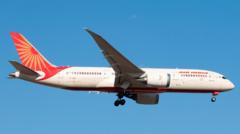The recent crash of Air India Flight 171, which occurred just moments after takeoff from Ahmedabad, has left investigators grappling with a complex puzzle. The Boeing 787 Dreamliner was airborne for less than 40 seconds when it tragically went down in a densely populated area, marking a rare aviation disaster in India.
Investigators face the daunting task of decoding the flight data and cockpit voice recorders—often referred to as the "black boxes"—to piece together the final seconds before the crash. According to international regulations set forth by the ICAO, a preliminary report detailing findings should be expected within 30 days, with a comprehensive final report to follow within a year.
The aircraft, en route to London Gatwick, was commanded by Captain Sumeet Sabharwal and co-pilot Clive Kundar and was carrying 242 passengers, along with nearly 100 tonnes of fuel. Moments after takeoff, a distress call was made from the cockpit, marking the last communication before the aircraft lost altitude and crashed in flames.
Aviation expert Captain Kishore Chinta has labeled this incident as “the rarest of the rare”—a controlled flight into terrain mere moments after takeoff. Various theories are presently under scrutiny, including potential engine failures connected to bird strikes or fuel contamination, improper flap extensions, maintenance errors, or inadvertent actions that cut off fuel supply to both engines.
The impact site provides crucial clues, with damage to the two engines playing a significant role in determining if they were operational at the moment of impact. Investigators will meticulously analyze every piece of wreckage, including fuel filters and valves, while also examining maintenance logs and the history of this specific aircraft and its crew.
The advanced flight data and cockpit recorders from the Boeing 787 promise a wealth of information that could reveal critical insights about the aircraft’s performance before the crash. Depending on the data retrieved, investigators will focus either on the performance of the engines or assess the effectiveness of the aircraft’s flight management control system.
Thus far, there has been no indication of wrongdoing, with India's civil aviation ministry reporting no major safety concerns following recent inspections. Boeing officials have echoed the commitment to cooperate with ongoing investigations in adherence to established protocols.
In wrapping up the investigation, experts have emphasized the significance of today’s advanced recording technologies, which track hundreds of parameters every second, enhancing the accuracy and swiftness of crash investigations. While a clear understanding of the incident may emerge relatively quickly, comprehending the causes behind it may take much longer, highlighting the intricate challenges faced within aviation safety and oversight.





















